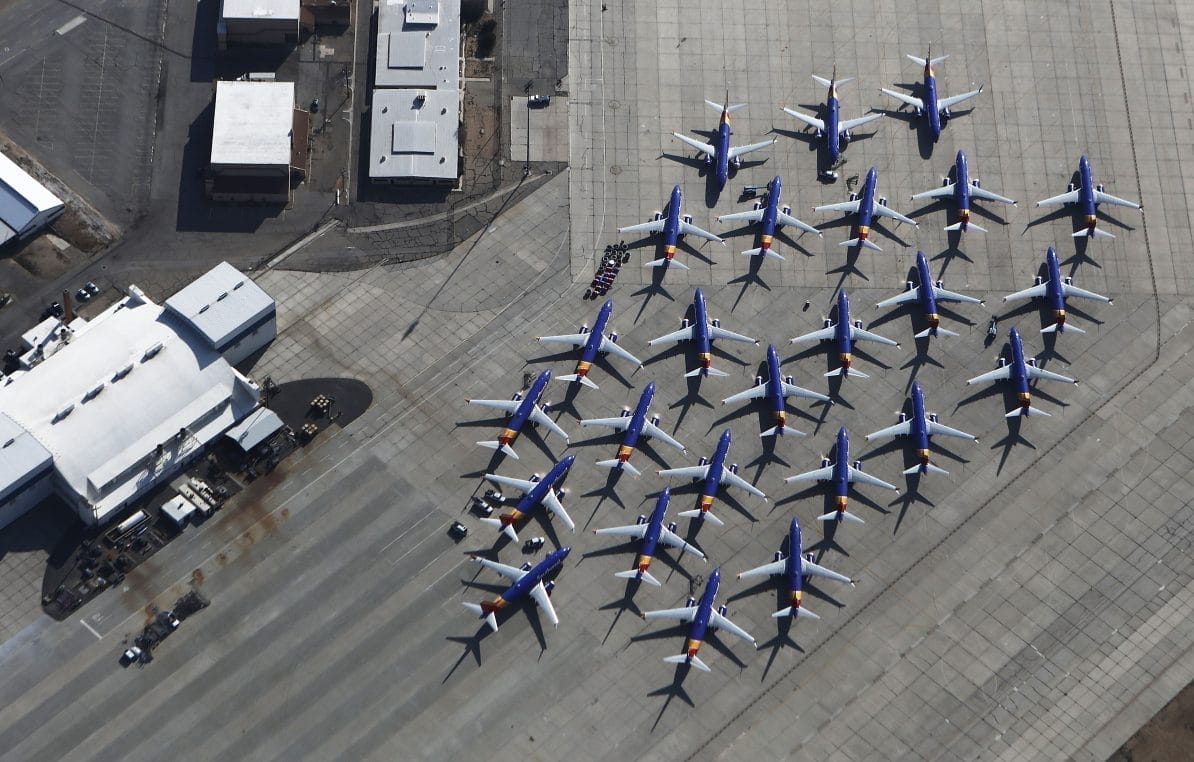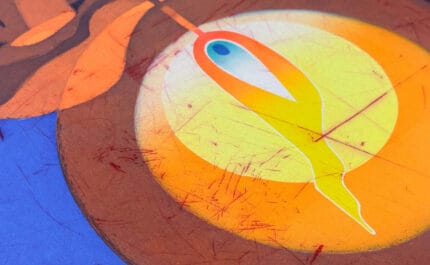Moment that mattered: Boeing’s entire global fleet of 737 MAX aircraft is grounded after a second crash
In March 2019 we spoke to aviation analyst Sally Gethin about how one bit of tech floored Boeing's new line of aircraft

Grounded Boeing 737 MAX aircraft at Southern California Logistics Airport, 27th March 2019. Photo: Mario Tama/Getty Images
13th March 2019 (Taken from: #34)
This article was published in Delayed Gratification in March 2019
On 13th March Boeing announced that it would ground all 371 of its 737 MAX planes in operation around the world due to safety concerns. The US plane-maker’s CEO Dennis Muilenburg said his company “continues to have full confidence in the safety of the 737 MAX” and that the move is a “proactive step out of an abundance of caution”. Aviation authorities around the world had already banned the plane from their airspace following the crash of Ethiopian Airlines Flight 302 three days earlier, which saw all 157 people onboard killed when the plane crashed six minutes after take-off. It was the second disaster involving the Boeing aircraft in less than five months, following the Lion Air crash of October 2018 in Indonesia which killed 189 people.
“I was very cautious in the early stages after the Ethiopian crash,” says Sally Gethin, an independent analyst who runs the Gethin’s Inflight News website. “But people were quickly making the assumption that there were similarities to Lion Air.” Analysts were able to get in-depth information on flight-tracking website Flightradar24, which in both cases showed a new Boeing 737 MAX 8 plane plunging minutes after take-off.
It seems so innocuous… How could this one little gizmo bring down an entire aircraft?
The preliminary evidence from both crashes suggested that the pilots struggled against Boeing’s automated flight software, known as the Maneuvering Characteristics Augmentation System (MCAS), which automatically lowers the aircraft’s nose using stabilisers on the tail to prevent it from stalling and crashing. “It seems so innocuous, this one little electronic device,” says Gethin. “How could this one little gizmo bring down an aircraft?”
An update of Boeing’s long-standing 737 workhorse, the MAX is a single-aisle plane with improved fuel efficiency, which the company hoped would help it compete with rival Airbus and its fuel-efficient A320neo model. “The problem with the MAX is its aerodynamics – the centre of gravity is different [to the older 737],” Gethin says. “They took the skinny airframe of the 737 and plunked massive great engines in it, which sit further forward. This means that when aircraft get airborne they tend to create a lot of speed and thrust and force the nose up. Boeing created MCAS to counteract the changed aerodynamics and make the plane safe, but the pilots were in a new situation. In both these tragedies the pilots were flying what seemed to them a very familiar aircraft, the old 737, but this was a quite different plane.”
According to preliminary evidence from air crash investigators in Indonesia and Ethiopia, the angle-of-attack (AOA) sensors on both planes sent incorrect data to MCAS indicating that the nose was pointing too high. MCAS responded by pushing the nose down to what it believed was a safe angle, but was in reality dangerously downward-facing. On the Lion Air flight it has been suggested that the pilots, who were unaware of the presence of MCAS, were able to temporarily counteract the software, but that the AOA sensors continued to send false data, resulting in a tug-of-war the pilots didn’t win. After the Indonesian crash Boeing issued new safety recommendations, yet the Ethiopian authorities say its initial investigations suggest that the pilots followed these recommendations and still failed to get the plane under control.
A tiny piece of technology has come to play an outsized role in the analyses of the crashes. “These aircraft didn’t have what’s called a ‘disagree light,’” says Gethin. “This light would have shown the pilots that the AOA sensors were giving false readings, but it turned out that disagree lights were optional features.” The light was not available as standard and around 80 percent of Boeing customers, including Lion Air and Ethiopian Airlines, didn’t pay for the separate cockpit indicator that was required for it to function. However, it is unclear whether a functioning disagree light would have saved any lives. Boeing says that the feature wasn’t necessary for safe flying.
One estimate is that for every month the MAX is grounded the cost to the industry is $1.5 billion
The US regulatory body, the Federal Aviation Administration (FAA), initially affirmed its faith in the plane after the 10th March crash, even as aviation authorities around the world issued bans. But on 13th March it buckled and grounded the 737 MAX. Three months later the planes remain grounded and there is no indication of when they will fly again. Boeing initially said it expected to fix its software in weeks, but weeks became months and as of mid-June both Boeing and the FAA said there was no timeframe for getting the MAX airborne again.
“One estimate is that for every month the MAX is grounded the cost to the industry is $1.5 billion,” says Gethin, explaining that there is tremendous pressure on Boeing to fix the problem from airlines which staked their future on MAX orders, and which now have numerous $100 million aircraft sitting in hangars. Southwest Airlines, the biggest customer of the aircraft in the US, is cancelling around 130 flights a day. Although Boeing’s cash reserves have been depleted by at least $1 billion due to the grounding, mainly because of a halt in jet deliveries, this is unlikely to be an existential crisis for the company, which last year saw record revenue of $101 billion.
The reputational hit to Boeing caused by the two incidents, however, was considerable. This was compounded by a series of reports in the New York Times in the weeks after the second crash which claimed that Boeing rushed through the 737 MAX project to maintain a competitive advantage with Airbus and that after the Indonesian crash American Airlines pilots, who were frustrated that nobody had told them about MCAS, were rebuffed by Boeing officials when they asked for the apparent flaw to be urgently dealt with.
Boeing also admitted that it discovered back in 2017 that the disagree light wasn’t functioning unless airlines had paid for optional equipment, and that it had withheld the information until after the Lion Air crash, when it informed the FAA.
The FAA’s role in the crisis has also come under scrutiny. “What’s coming out of this whole apocalyptic story is that there was too cosy a relationship between Boeing and the FAA,” says Gethin. “They designated Boeing staff as their regulators. Clearly there’s a massive conflict of interest.” On 11th April the New York Times reported that the FAA didn’t conduct any safety reviews of critical changes to MCAS, which made the system active in a broader range of situations.
It remains to be seen whether travellers will want to fly in the 737 MAX in the future. “We’re seeing a backlash amongst the travelling public,” says Gethin. A June survey showed that only 14 percent of passengers would definitely fly on the 737 MAX within six months of it being returned to service. More than 40 percent would book more expensive or less convenient flights to avoid the aircraft. “The $64 million question is whether people will get back on board the 737 MAX in the kind of numbers to make it cost effective for the airlines to still operate it,” Gethin says. “The memory of the travelling public is notoriously short, but there isn’t any sign of public nervousness abating at the moment and don’t forget we’re going to have lots of lawsuits keeping the story in the news cycle.”
These lawsuits are from shareholders, over the alleged concealing of safety deficiencies, airline pilots and the families of the bereaved.
Three months of reporting on a major corporate crisis has perhaps overshadowed the human tragedy – 346 passengers were killed in the two crashes. “We still don’t yet have the full and final report of the Ethiopian Airlines crash, and the Lion Air incident is still an ongoing investigation,” says Gethin, adding that we have no idea how long it will take. For the victims’ families, the wait for definitive answers might be a lengthy one.
Boeing received an unexpected shot in the arm at the Paris Air Show on 18th June when IEG, the multinational that owns British Airways, bought 200 737 MAX aircraft in an order worth more than $24 billion. “It might look like it’s all come to a screaming halt but these aircraft are still being rolled off the assembly line in anticipation of going back in to service,” says Gethin. “In many ways it’s business as usual for Boeing.”
Slow Journalism in your inbox, plus infographics, offers and more: sign up for the free DG newsletter. Sign me up
Thanks for signing up.








